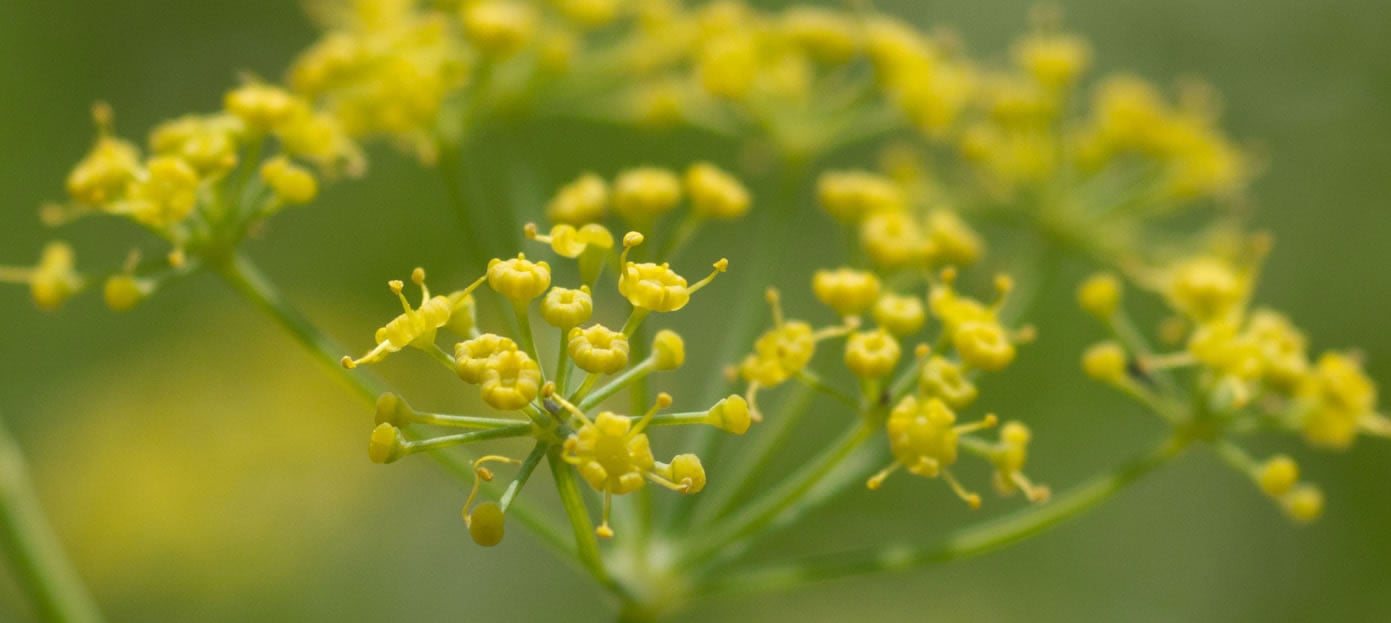Fennel

The Sanskrit name for fennel is 'Shatapushpa' which means 'one hundred flowers', describing fennel's distinctively beautiful tiny umbels of vibrant yellow flowers. All members of the Apiaceae family, commonly known as the carrot or parsley family, are large and aromatic and display their small flowers in distinctive ascendant umbels, similar to those of cow parsley. Fennel grows up to 2.5m tall and has large, beautiful, aniseed-scented feathery leaves.
Fennel is also an effective expectorant within the respiratory system, encouraging the release of stuck mucous and catarrh. Fennel stimulates the libido and is particularly supportive to the female reproductive system, encouraging efficient menstruation and reducing the painful and spasmodic symptoms of dysmenorrhea. For breastfeeding mums, fennel will also promote efficient lactation.
Clinical References
- Anti-inflammatory, analgesic and antioxidant
activities of the fruit of Foeniculum vulgare.
Fitoterapia. 2004 Sep;75(6):557-65. - Comparison of fennel and mefenamic acid for the
treatment of primary dysmenorrhea. Int J Gynaecol
Obstet. 2003 Feb;80(2):153-7.
A Bitter Sweet Tale
Depending on the country of origin and the latitude where it is grown, fennel plants produce seeds with
extremely varied essential oil content and essential oil composition. It is the essential oil content that determines the sweetness and bitterness detected in the taste of the plant.
Fennel is cultivated on a huge scale in many parts of the world. Fennel grown in Turkey has the highest
essential oil content with more than 85% anethole. This gives the plant a particularly sweet taste.
The information below displays the vast differences in essential oil content, specifically anethole, across three different global locations:
European Pharmacopeia Standards
Essential Oil Component: Minimum 2%
Anethole (% of EO): Minimum 80%
Turkish Fennel
Essential Oil Component: 2.7%
Anethole (% of EO): 85%
Egyptian Fennel
Essential Oil Component: 2.1%
Anethole (% of EO): 0.9%
Indian Fennel
Essential Oil Component: 1.3%
Anethole (% of EO): 73.4%
Fennel is a perennial plant that is often grown as an annual. In warm climates, fennel plantations can remain in the same plot for up to 10 years, although the average productive life is around 6 years. Many people associate fennel with the bulbous base of the plant that is cooked as a vegetable. This is a modified variety that has been created through years of careful selection and breeding.
A Little Bit Of Chemistry
The primary medicinal constituent in fennel is known as anethole. It is this component that gives fennel its characteristic taste and smell, often likened to that of anise and camphor. Anethole is a potent anti-microbial against bacteria, yeasts and fungi. It is also an effective anthelmintic used in the treatment of a wide range of infections in the digestive tract. Anethole also modulates the tumour necrosis factor helping reduce inflammation.
In addition to anethole, fennel contains 12 major phenolic compounds and a high level of flavonoids. The phenolic compounds have displayed strong free radical scavenging activity, making fennel an impressive anti-oxidant. Flavonoids are characteristically anti-inflammatory supporting fennel's activities in the body as an anti-oxidant and anti-microbial.
Constituent
Phenolics 30-40% (approx.)
Flavonoids 15%
Essential Oils, including Anethole 2-6%

